Abstract
1. We investigated the role of N-methyl-D-aspartic acid (NMDA) receptors in mediating hypoxic excitation of the reticulospinal vasomotor neurones of the rostroventrolateral reticular nucleus (RVL) of the medulla oblongata in paralysed ventilated rats. 2. Unilateral close arterial injection of sodium cyanide (100 nmol) into the carotid sinus region or ventilation with 100% N2 for 12 s rapidly, reversibly and reproducibly excited the RVL-spinal vasomotor neurones, followed about 1-2 s later by increases in sympathetic nerve activity and arterial pressure, effects abolished by denervation of the ipsilateral carotid sinus nerve. 3. Ionophoresis onto the RVL-spinal vasomotor neurones of kynurenate (a wide-spectrum antagonist of the excitatory amino acid receptors) or of 2-amino-5-monophosphovaleric acid (APV; a selective NMDA receptor antagonist), but not of xanthurenate (an inactive analogue of kynurenate), blocked the excitation elicited by intracarotid cyanide or 12 s of hypoxia. Kynurenate completely and APV partially blocked the excitatory responses to ionophoretically applied L-glutamate. APV, however, did not alter the excitatory responses of the vasomotor neurones to ionophoreses of kainate and quisqualate. 4. Bilateral microinjection of kynurenate (10 nmol, 50 nl per site) or APV (5 nmol, 50 nl per site) into the RVL blocked the increases in arterial pressure elicited by intracarotid cyanide or 12 s of 100% N2 ventilation. 5. Twenty seconds of intratracheal administration of 100% N2 resulted in complex and prolonged elevations of arterial pressure, the late component of which was affected neither by sinus denervation nor by microinjections of kynurenate or APV into the RVL. 6. We conclude that the sympathetic and cardiovascular responses to stimulation of arterial chemoreceptors result from excitation of RVL-spinal vasomotor neurones via activation of the NMDA subtypes of the excitatory amino acid receptors of the neurones. In contrast, the failure of these antagonists to influence the delayed excitation of the RVL-spinal vasomotor neurons by more prolonged exposure to N2 inhalation further supports the view that these neurones are directly stimulated by hypoxia.
Full text
PDF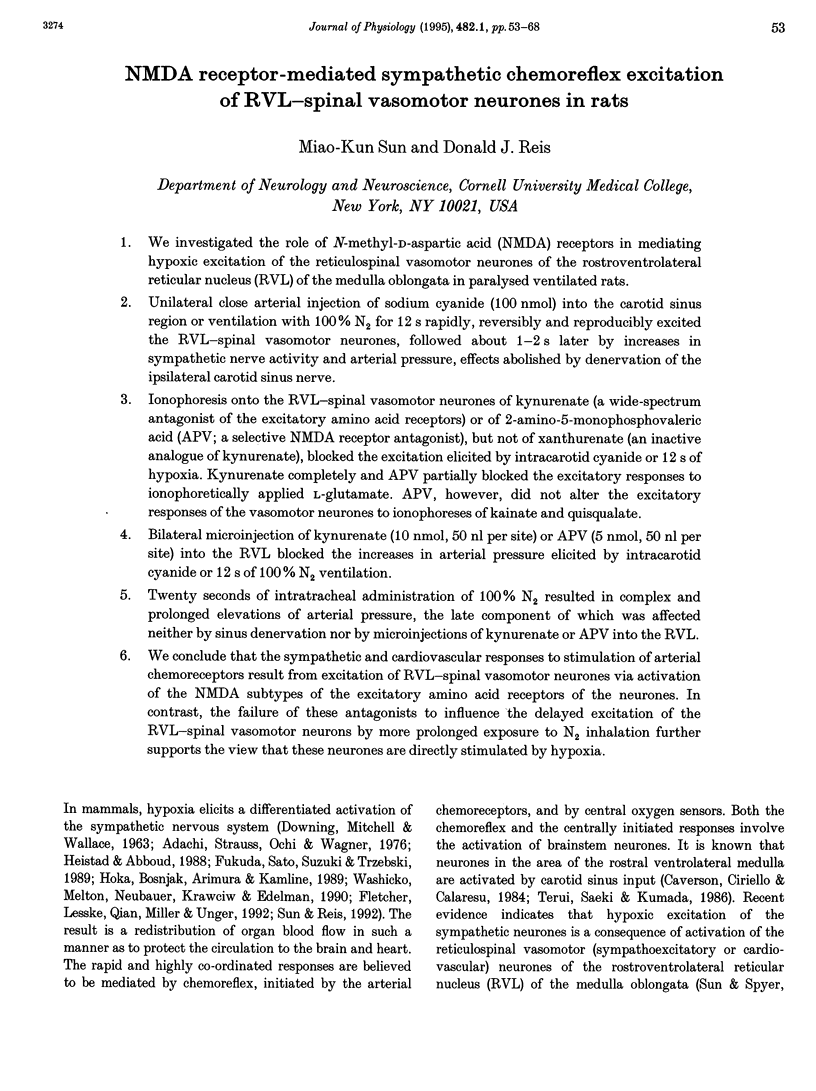




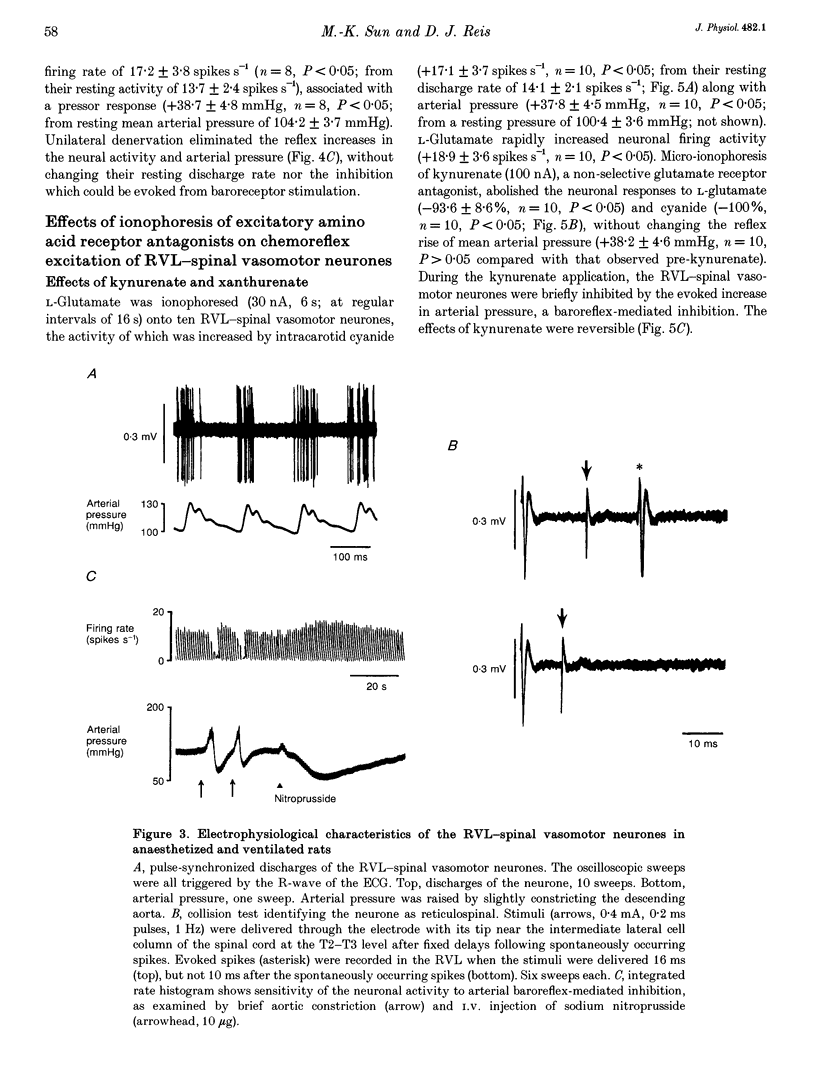


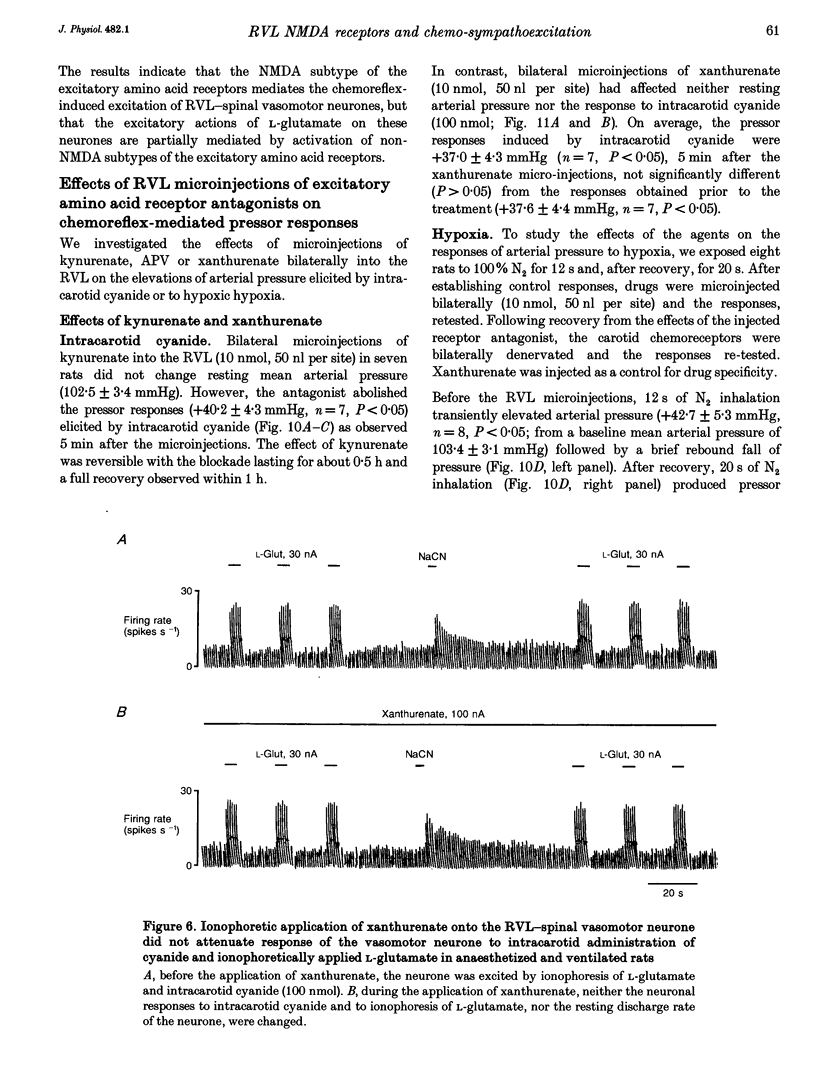

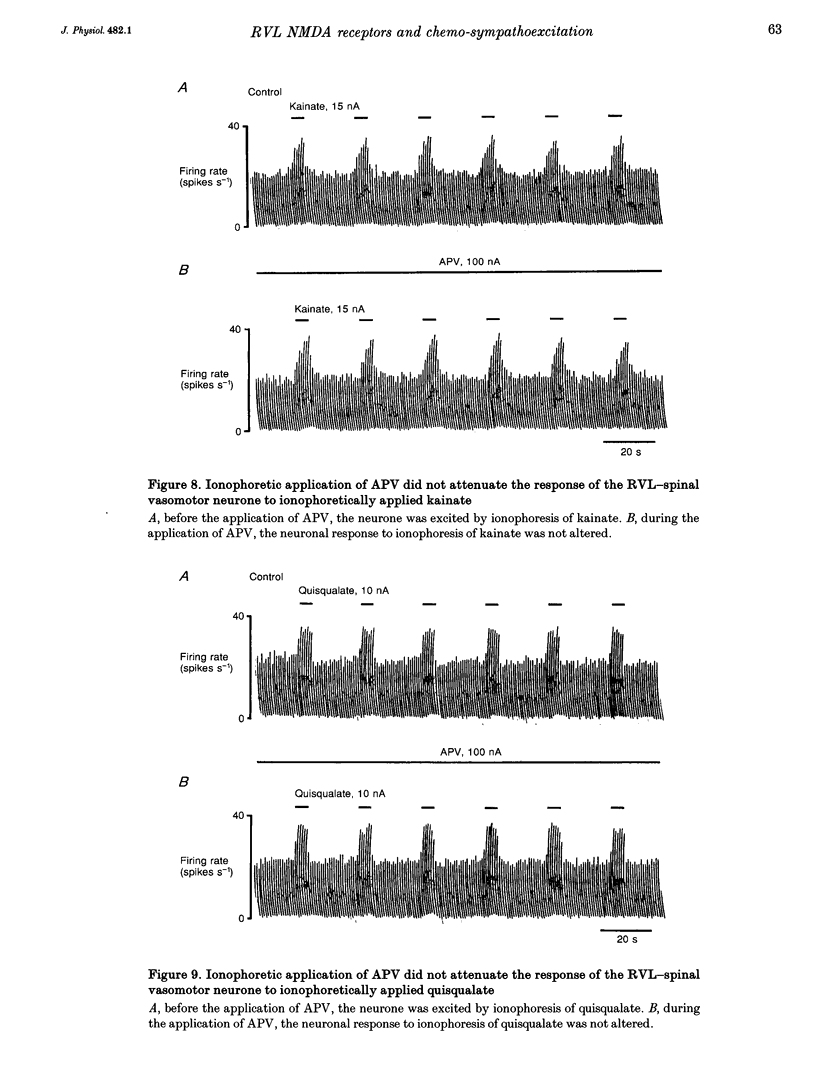
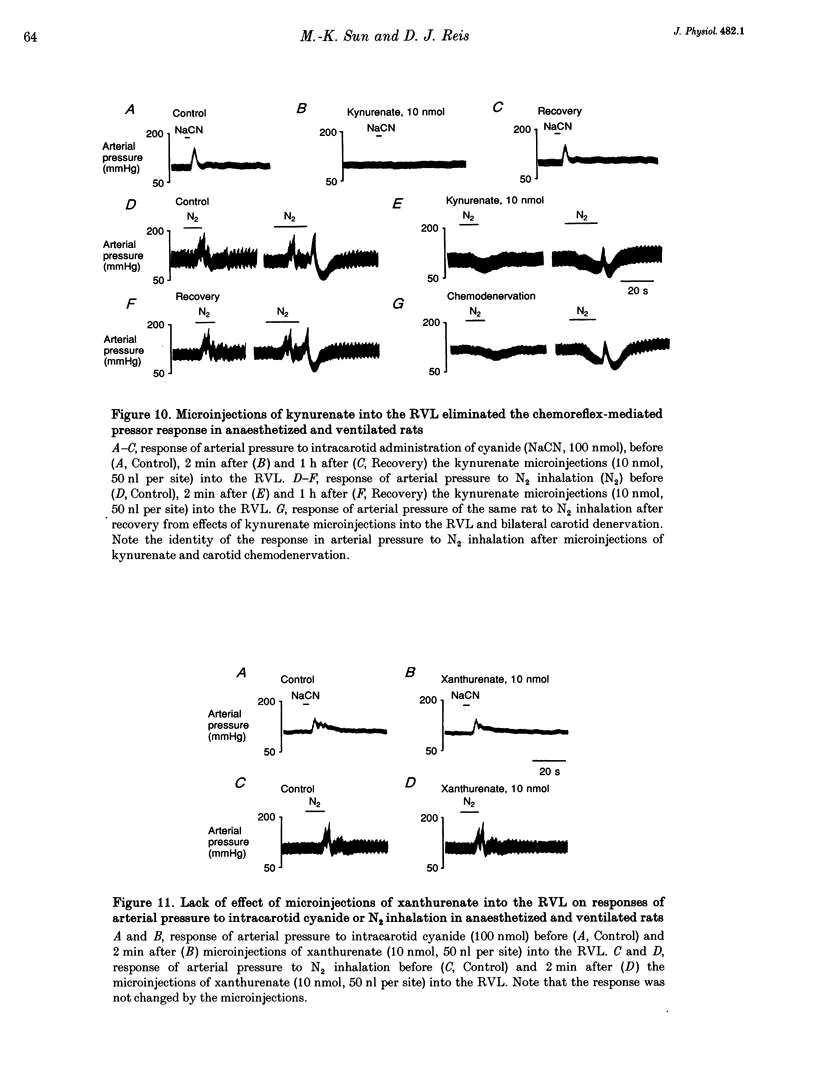

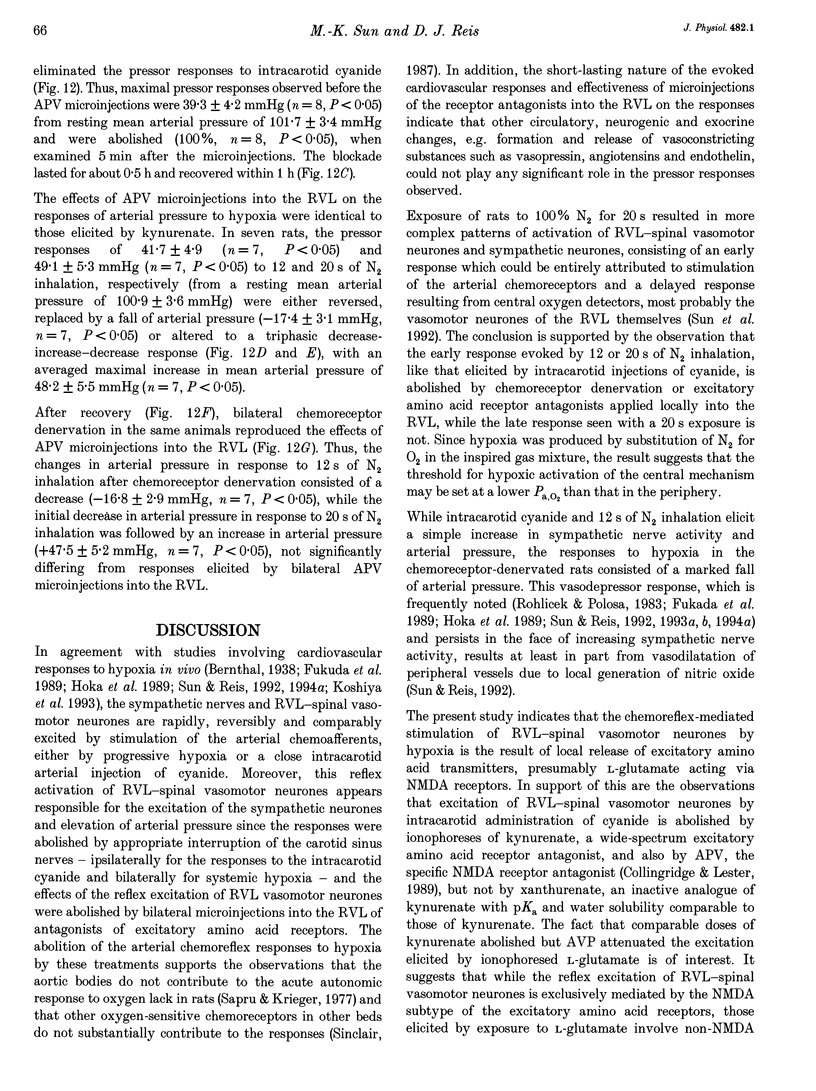

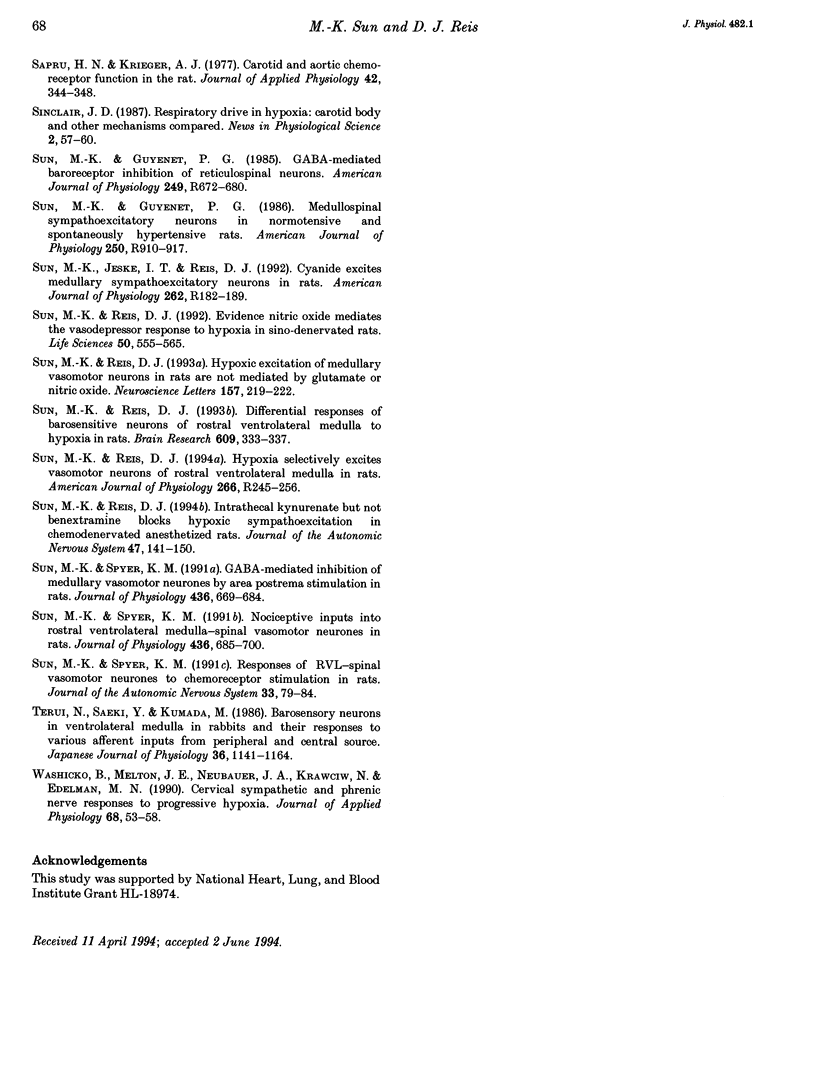
Selected References
These references are in PubMed. This may not be the complete list of references from this article.
- Adachi H., Strauss W., Ochi H., Wagner H. N., Jr The effect of hypoxia on the regional distribution of cardiac output in the dog. Circ Res. 1976 Sep;39(3):314–319. doi: 10.1161/01.res.39.3.314. [DOI] [PubMed] [Google Scholar]
- Biscoe T. J., Duchen M. R. Cellular basis of transduction in carotid chemoreceptors. Am J Physiol. 1990 Jun;258(6 Pt 1):L271–L278. doi: 10.1152/ajplung.1990.258.6.L271. [DOI] [PubMed] [Google Scholar]
- Biscoe T. J., Duchen M. R. Electrophysiological responses of dissociated type I cells of the rabbit carotid body to cyanide. J Physiol. 1989 Jun;413:447–468. doi: 10.1113/jphysiol.1989.sp017663. [DOI] [PMC free article] [PubMed] [Google Scholar]
- Caverson M. M., Ciriello J., Calaresu F. R. Chemoreceptor and baroreceptor inputs to ventrolateral medullary neurons. Am J Physiol. 1984 Nov;247(5 Pt 2):R872–R879. doi: 10.1152/ajpregu.1984.247.5.R872. [DOI] [PubMed] [Google Scholar]
- Collingridge G. L., Lester R. A. Excitatory amino acid receptors in the vertebrate central nervous system. Pharmacol Rev. 1989 Jun;41(2):143–210. [PubMed] [Google Scholar]
- Fletcher E. C., Lesske J., Qian W., Miller C. C., 3rd, Unger T. Repetitive, episodic hypoxia causes diurnal elevation of blood pressure in rats. Hypertension. 1992 Jun;19(6 Pt 1):555–561. doi: 10.1161/01.hyp.19.6.555. [DOI] [PubMed] [Google Scholar]
- Fukuda Y., Sato A., Suzuki A., Trzebski A. Autonomic nerve and cardiovascular responses to changing blood oxygen and carbon dioxide levels in the rat. J Auton Nerv Syst. 1989 Oct;28(1):61–74. doi: 10.1016/0165-1838(89)90008-8. [DOI] [PubMed] [Google Scholar]
- Guyenet P. G., Brown D. L. Unit activity in nucleus paragigantocellularis lateralis during cerebral ischemia in the rat. Brain Res. 1986 Feb 5;364(2):301–314. doi: 10.1016/0006-8993(86)90843-7. [DOI] [PubMed] [Google Scholar]
- Heistad D. D., Abboud F. M. Dickinson W. Richards Lecture: Circulatory adjustments to hypoxia. Circulation. 1980 Mar;61(3):463–470. doi: 10.1161/01.cir.61.3.463. [DOI] [PubMed] [Google Scholar]
- Hoka S., Bosnjak Z. J., Arimura H., Kampine J. P. Regional venous outflow, blood volume, and sympathetic nerve activity during severe hypoxia. Am J Physiol. 1989 Jan;256(1 Pt 2):H162–H170. doi: 10.1152/ajpheart.1989.256.1.H162. [DOI] [PubMed] [Google Scholar]
- Koshiya N., Huangfu D., Guyenet P. G. Ventrolateral medulla and sympathetic chemoreflex in the rat. Brain Res. 1993 Apr 23;609(1-2):174–184. doi: 10.1016/0006-8993(93)90871-j. [DOI] [PubMed] [Google Scholar]
- Paintal A. S. Mechanism of stimulation of aortic chemoreceptors by natural stimuli and chemical substances. J Physiol. 1967 Mar;189(1):63–84. doi: 10.1113/jphysiol.1967.sp008155. [DOI] [PMC free article] [PubMed] [Google Scholar]
- Rohlicek C. V., Polosa C. Hypoxic responses of sympathetic preganglionic neurons in sinoaortic-denervated cats. Am J Physiol. 1983 May;244(5):H681–H686. doi: 10.1152/ajpheart.1983.244.5.H681. [DOI] [PubMed] [Google Scholar]
- Sapru H. N., Krieger A. J. Carotid and aortic chemoreceptor function in the rat. J Appl Physiol Respir Environ Exerc Physiol. 1977 Mar;42(3):344–348. doi: 10.1152/jappl.1977.42.3.344. [DOI] [PubMed] [Google Scholar]
- Sun M. K., Guyenet P. G. GABA-mediated baroreceptor inhibition of reticulospinal neurons. Am J Physiol. 1985 Dec;249(6 Pt 2):R672–R680. doi: 10.1152/ajpregu.1985.249.6.R672. [DOI] [PubMed] [Google Scholar]
- Sun M. K., Guyenet P. G. Medullospinal sympathoexcitatory neurons in normotensive and spontaneously hypertensive rats. Am J Physiol. 1986 May;250(5 Pt 2):R910–R917. doi: 10.1152/ajpregu.1986.250.5.R910. [DOI] [PubMed] [Google Scholar]
- Sun M. K., Jeske I. T., Reis D. J. Cyanide excites medullary sympathoexcitatory neurons in rats. Am J Physiol. 1992 Feb;262(2 Pt 2):R182–R189. doi: 10.1152/ajpregu.1992.262.2.R182. [DOI] [PubMed] [Google Scholar]
- Sun M. K., Reis D. J. Differential responses of barosensitive neurons of rostral ventrolateral medulla to hypoxia in rats. Brain Res. 1993 Apr 23;609(1-2):333–337. doi: 10.1016/0006-8993(93)90892-q. [DOI] [PubMed] [Google Scholar]
- Sun M. K., Reis D. J. Evidence nitric oxide mediates the vasodepressor response to hypoxia in sino-denervated rats. Life Sci. 1992;50(8):555–565. doi: 10.1016/0024-3205(92)90367-x. [DOI] [PubMed] [Google Scholar]
- Sun M. K., Reis D. J. Hypoxia selectively excites vasomotor neurons of rostral ventrolateral medulla in rats. Am J Physiol. 1994 Jan;266(1 Pt 2):R245–R256. doi: 10.1152/ajpregu.1994.266.1.R245. [DOI] [PubMed] [Google Scholar]
- Sun M. K., Reis D. J. Hypoxic excitation of medullary vasomotor neurons in rats are not mediated by glutamate or nitric oxide. Neurosci Lett. 1993 Jul 23;157(2):219–222. doi: 10.1016/0304-3940(93)90741-3. [DOI] [PubMed] [Google Scholar]
- Sun M. K., Reis D. J. Intrathecal kynurenate but not benextramine blocks hypoxic sympathoexcitation in chemodenervated anesthetized rats. J Auton Nerv Syst. 1994 Apr;47(1-2):141–150. doi: 10.1016/0165-1838(94)90075-2. [DOI] [PubMed] [Google Scholar]
- Sun M. K., Spyer K. M. GABA-mediated inhibition of medullary vasomotor neurones by area postrema stimulation in rats. J Physiol. 1991 May;436:669–684. doi: 10.1113/jphysiol.1991.sp018572. [DOI] [PMC free article] [PubMed] [Google Scholar]
- Sun M. K., Spyer K. M. Nociceptive inputs into rostral ventrolateral medulla-spinal vasomotor neurones in rats. J Physiol. 1991 May;436:685–700. doi: 10.1113/jphysiol.1991.sp018573. [DOI] [PMC free article] [PubMed] [Google Scholar]
- Sun M. K., Spyer K. M. Responses of rostroventrolateral medulla spinal vasomotor neurones to chemoreceptor stimulation in rats. J Auton Nerv Syst. 1991 Apr;33(1):79–84. doi: 10.1016/0165-1838(91)90020-4. [DOI] [PubMed] [Google Scholar]
- Terui N., Saeki Y., Kumada M. Barosensory neurons in the ventrolateral medulla in rabbits and their responses to various afferent inputs from peripheral and central sources. Jpn J Physiol. 1986;36(6):1141–1164. doi: 10.2170/jjphysiol.36.1141. [DOI] [PubMed] [Google Scholar]
- Wasicko M. J., Melton J. E., Neubauer J. A., Krawciw N., Edelman N. H. Cervical sympathetic and phrenic nerve responses to progressive brain hypoxia. J Appl Physiol (1985) 1990 Jan;68(1):53–58. doi: 10.1152/jappl.1990.68.1.53. [DOI] [PubMed] [Google Scholar]


